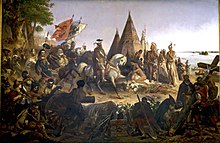 On May 8, 1541, Spanish explorer Hernando de Soto became the first recorded European to reach the Mississippi River, which he called Río del Espíritu Santo ("River of the Holy Spirit"), in the area of what is now Mississippi. In Spanish, the river is called Río Mississippi.
On May 8, 1541, Spanish explorer Hernando de Soto became the first recorded European to reach the Mississippi River, which he called Río del Espíritu Santo ("River of the Holy Spirit"), in the area of what is now Mississippi. In Spanish, the river is called Río Mississippi.French explorers, Louis Jolliet and Jacques Marquette, began exploring the Mississippi in the 17th century. Marquette traveled with a Sioux who named it Ne Tongo ("Big river" in Sioux language) in 1673. Marquette proposed calling it the River of the Immaculate Conception.
In 1682, René-Robert Cavelier, Sieur de La Salle and Henri de Tonti claimed the entire Mississippi River Valley for France, calling the river Colbert River after Jean-Baptiste Colbert and the region La Louisiane, for King Louis XIV. On March 2, 1699, Pierre Le Moyne d'Iberville rediscovered the mouth of the Mississippi, following the death of La Salle. The French built the small fort of La Balise there to control passage.
In 1718, about 100 miles (160 km) upriver, New Orleans was established along the river crescent by Jean-Baptiste Le Moyne, Sieur de Bienville, with construction patterned after the 1711 resettlement on Mobile Bay of Mobile, the capital of French Louisiana at the time.
0 comments:
Post a Comment